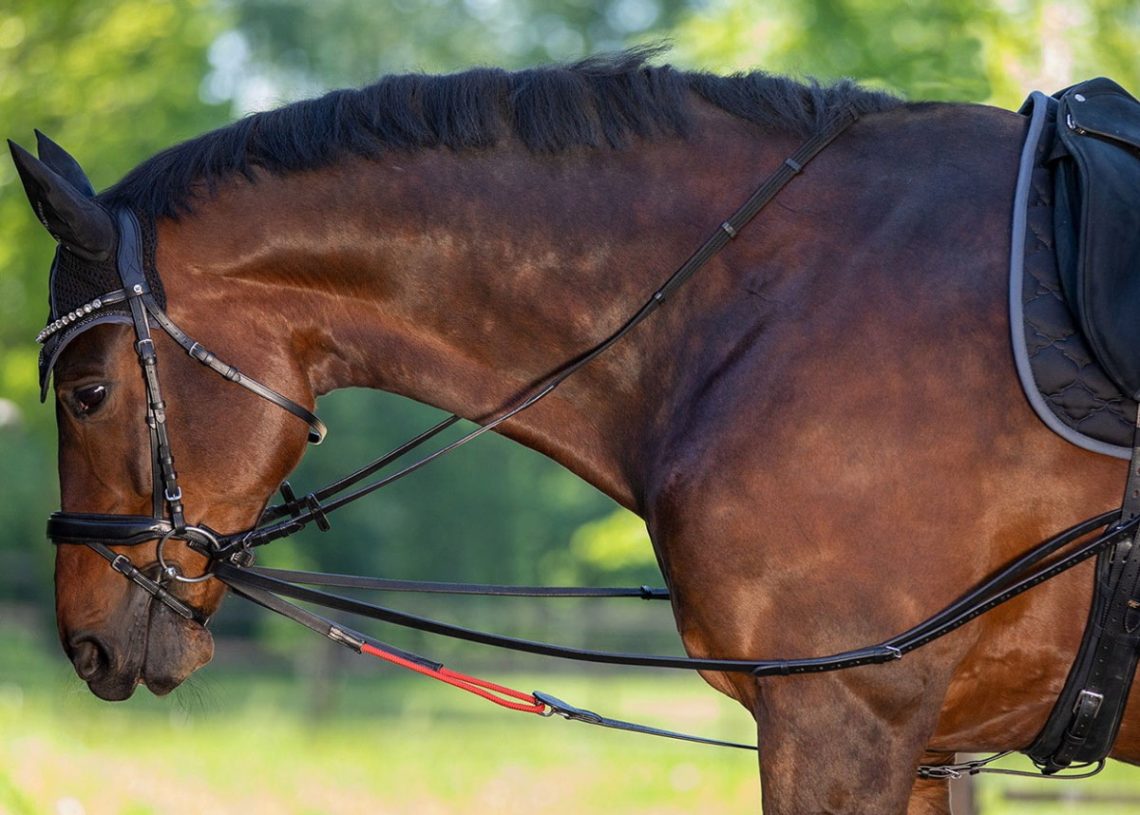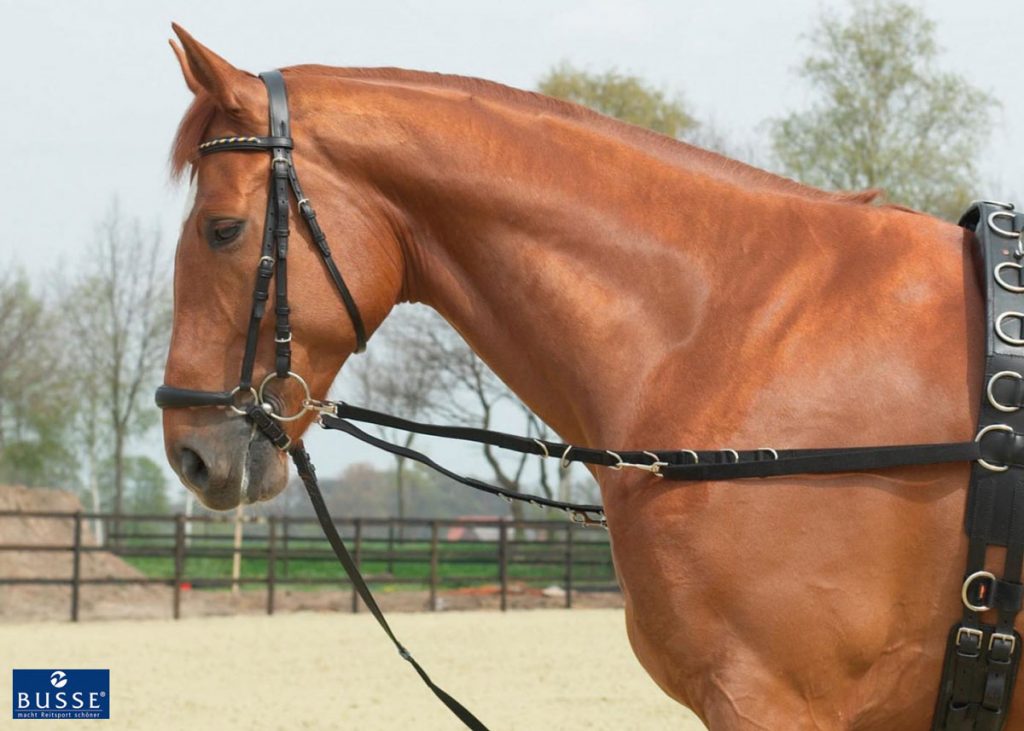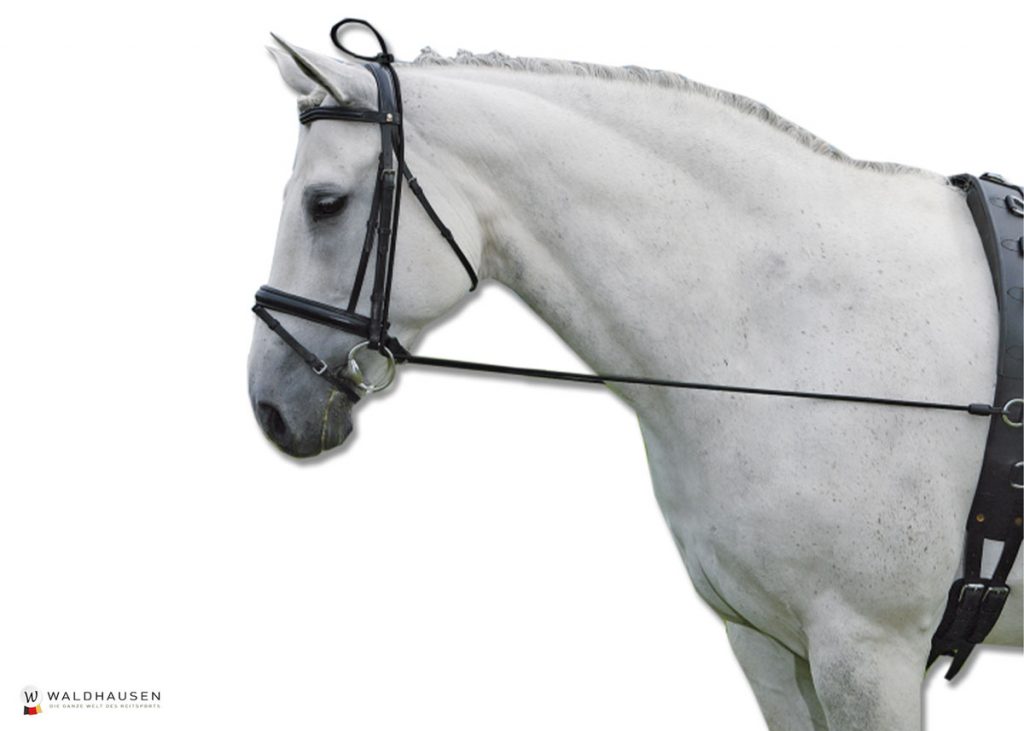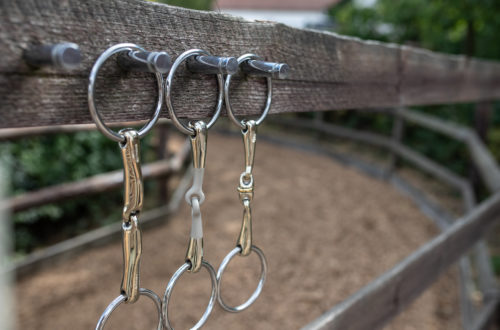
Use auxiliary reins correctly - types, use, advantages & disadvantages
The sense and nonsense of auxiliary reins has been discussed ever since man sat on a horse. Some use correctly buckled auxiliary reins as support, others demonize them as instruments of torture. It's not that easy to form an opinion.
Unfortunately, you always see incorrectly applied auxiliary reins, which of course further supports the headwind. Images of hyperflexion of the neck caused by draw reins, also called roll cures, are common in equestrian sports and spread like wildfire. However, correctly applied auxiliary reins are not fundamentally bad. Because they do what they are named for - help! For the beginner and the horse.
Directly to the auxiliary reins: Training reins | Triangle reins | Thiedemann reins | Walker reins | Chambon & Gouge | Neck extender | Draw reins | Martingale
General information about auxiliary reins
Auxiliary reins (or reins) should support the beginner. Of course, this is not immediately properly balanced, the horse cannot ride in the correct leaning and in most cases there is also a problem with the seat. Correct hand position, correct seat, correct aids and then also see where you are going. All of this can overwhelm a new rider at first. Auxiliary reins should help to feel and learn the correct fit. Because if the horse is limited at the front by the auxiliary reins, the rider can only concentrate on the seat. In the best case, the horse should then arch its back and let its neck drop.
The goal of any riding training is to ride without any auxiliary reins!
Whether triangular reins, reins, runner reins or chambon - the auxiliary reins are only strapped in after the horse has warmed up! In addition, auxiliary reins should be removed in the field. The exception here is the martingale, which, however, has a special position under the auxiliary reins.
Well-known auxiliary reins are the side reins, the Viennese or triangular reins and Thiedemann or Lauffer reins. Auxiliary reins that should only be used by experienced riders include draw reins, chambon or gogue.
With auxiliary reins, as with all aids (whether weight, thigh or rein aid), the principle applies: As much (use) as necessary, as little (use) as possible!
You can find all auxiliary reins HERE
But now to the auxiliary reins and how they are used:
Correctly insert the bridging reins

Every beginner rider knows the bridle. Side reins always consist of two individual "reins" that are attached to the left and right between the bit ring and the saddle girth. Make sure that the reins are buckled high or low on the saddle girth so that they are horizontal when the horse is walking with the head in the correct position. They must be set so long that the horse does NOT get behind the vertical when leaning correctly.
The advantage of strapping:
Binder give the horse a clear framework, because it is limited in front and on the sides. The rider can concentrate on his seat and let the rein a little loose so as not to disturb the horse's mouth. The binding reins are also often used when lunging or doing manual work to limit the horse, especially at the sides.
The disadvantage of trimming:
Even with correctly buckled girders, it is not possible for the horse to stretch forwards and downwards. Because of the forward limitation, when you stretch down, it comes behind the reins and curls up. When rebinding with elastic components (rubber rings or elastic inserts) it can happen that the horse lies down on the rebinder and lets its head be comfortably carried instead of carrying itself. The result is a silt on the forehand and a horse that feels very heavy in the hand.
And finally ...
Binder are suitable for beginners on the lunge or the first riding lessons in a group. Where the steady rider's hand and the right influence are still missing, the reins can have a supportive effect. Important: Only strap in the side straps after they have warmed up and remove them again after work. Then the horse can stretch a little and is only limited during the work phase.
Triangle reins or wiener reins

Triangle reins are a very popular form of auxiliary reins alongside the side reins. They are also often used for lunging. The triangular rein consists of a thick strap that runs between the front legs and is attached to the center of the saddle girth. In front of the chest, the thick strap forks into two individual, slightly thinner straps. These are passed from the inside to the outside through the respective bit ring on the left and right and attached to the saddle girth (or lunging girth). When the head is in the correct position, the strap should be slightly horizontal just before the vertical.
The advantage of triangular reins:
This is ideal for beginners who are not yet able to properly approach the horse by hand, but who are already able to limit it with their legs and reins Triangle reins on. The horse can find the forward-down stretch and the back can swing. In addition, the triangular reins prevent the horse from pulling its head up.
The disadvantage of triangular reins:
Triangles hardly offer any lateral delimitation. In addition, the horse gets behind the reins if it gets too deep. A forward-downward movement is possible, but only up to a certain point.
And finally ...
Triangular reins are a good help for beginners who have already mastered lateral aids but still need support to the front. These auxiliary reins can also be used well when lunging, because they offer the horse the opportunity to stretch to a certain depth.
The Thiedemann reins - also called Köhler reins

The Thiedemann or Köhler reins can be understood as a somewhat defused variant of the draw reins. It consists of reins with rings and the actual auxiliary reins. The ring is placed loosely around the horse's neck and the wide strap is passed through the front legs to the saddle girth. The two narrow straps are led from the inside to the outside through the respective bit ring on the left and right and attached to the rings on the reins. Of the Thiedemann reins must be strapped in such a way that it is only used when the horse takes its head too far forward or up.
The advantage of Thiedemann reins:
Instead of riding with two pairs of reins, as with the draw reins, the rider only holds one pair of reins in his hands. The Thiedemann reins only work when the horse is buckled up correctly if the horse takes its head too far forward or up. In addition, the rider cannot act harder if the horse is walking in the correct position, because then the Thiedemann reins should sag slightly.
The disadvantage of Thiedemann reins:
If used incorrectly, the Thiedemann rein leads to a blunt horse's mouth. In addition, it has no lateral limitation. Since it is a rather sharp auxiliary rein, it only belongs in calm and experienced rider hands. The rider must be able to ride the reins independently and may only use this reins for short corrections.
And finally ...
The Thiedemann reins must NOT be used by beginners. It belongs exclusively to the fine rider's hands and is used only for short corrections. Therefore it is more likely to be assigned to the proofing tools than to the auxiliary reins. Wrong use of this rein can harm the horse!
Runner reins / Phillips reins - convertible all-purpose aid

The Walker reins at first glance reminds of a triangular reins. But unlike this, the Lauffereins consist of two individual leather or nylon straps. It is probably the most variable auxiliary reins that can be used.
The buckling options:
The Phillips reins are buckled up like a triangle reins for solving problems and for keeping the stretch. Both straps are attached to the bottom of the saddle girth and passed between the front legs. Now guide it from the inside to the outside through the respective bit ring and attach it to the saddle girth on the right and left.
In order to achieve a higher erection or more lateral limitation, one end is buckled in higher up. Now the running reins are passed through the respective bit ring from top to bottom (i.e. from the outside to the inside) and attached to the saddle belt or a ring on the lunging belt again at the level of the nose joint (see picture). As a result, the horse has a stronger lateral limitation and is encouraged to hold its head higher. The effect is intensified the further up the auxiliary reins are attached. In any case, the horse must be able to keep the forehead-nose line in front of the vertical.
It is said to have happened that riders have also converted this auxiliary reins into a lunging aid or a draw reins. However, this is not the point and purpose of the Laufferzug.
The advantage of the walker reins:
The Lauffer or Phillips reins can be used both for stretching and for straightening. The simple construction with snap hooks enables quick conversion.
The disadvantage of the walker reins:
As with the triangular reins, the horse can get behind the vertical and curl up if it wants to stretch too far towards the ground. In addition, there is hardly any lateral limitation when buckling up as triangular reins. When strapping for erection, the walker rein is not suitable for loosening. In addition, you have to pay close attention to the length of the auxiliary rope so that the horse does not curl up and get stuck in the neck.
And finally ...
The various possible uses make the walker reins a variable auxiliary reins. It can be used both as a support for beginners, as an auxiliary reins for lunging and as a support for straightening. The latter should only be done over short stages and only with an experienced rider.
The Chambon and the Gogue - no auxiliary reins for beginners

Chambon and Gogue are used to teach the horse to lower its head when pressure is applied to its mouth and neck. Chambon and Gogue are suitable for horses who find it difficult to stretch and struggle to drop their necks. If the horse lifts its head too high, Chambon and Gogue press the neck and corner of the mouth. If the horse now lowers its head, the pressure eases. If the posture is correct, there is no help at all. In contrast to the chambon, the gogue can also be used under the rider.
The chambon may only be used when lunging, as the rider has to give in the reins very quickly as soon as the horse shows the slightest forward-downward tendency. Hardly any rider has this responsiveness.
Chambon and Gogue only belong in the very experienced rider's hands. Wrong buckling can lead to a violent defense reaction from the horse. Use these auxiliary reins only if you are under supervision up to and only in individual cases.
The difference between Chambon and Gogue
As you can see in the picture, the difference lies in the buckling of the auxiliary reins. With the independent gogue, the rubber goes through the bit and back into the strap from the saddle girth, thus forming a triangle. With the guided gogue there are two options: either the ends are strapped to the reins as with the Thiedemann reins, or the rider holds a second pair of reins in their hands, as with draw reins. The chambon is inserted so that the strap ends at the bit rings.
Disadvantages of the chambons:
The chambon offers neither the possibility of leaning against it, nor a lateral limitation. Many horses curl up to avoid pressure on the corner of their mouth and neck instead of stretching forward and downward. If it is buckled too short, it can tighten. On the other hand, if it is strapped too long, it can become a trip hazard.
Cons of the Gogue:
With the independent gogue, in addition to the disadvantages mentioned with the chambon, there is also a backward-looking effect. The guided gogue has the same disadvantages as a draw reins and is just as careful to use.
And finally ...
Chambon and Gogue are not real auxiliary reins, but rather correction aids that should be used very carefully. They are neither suitable for beginners nor for "trying out while lunging whether it will do anything". A riding instructor or rider should always be present who is very familiar with this type of auxiliary reins. As mentioned above, incorrect use can lead to a violent defensive reaction and, in the worst case, seriously injure the horse. These two auxiliary reins should therefore be used with caution and before use it should be considered whether health problems (tension in the neck, the ganache or the withers) are responsible.
The neck extender - wrongly named, because nothing extends here

The sense and nonsense of this type of auxiliary reins is hotly debated. The name neck extender is believed to induce the horse to stretch its neck. But the more the horse stretches, the higher the pressure on the bit and neck. If the head is in a normal position, the neck extender has no effect because it then has to sag. It is often buckled too tightly. If the horse now stretches in depth, the elastic strap tightens and the pressure increases. The horse then either crawls behind the reins to avoid the pressure - or lies down on the reins and becomes lame. The neck extender can still have an upwardly limiting effect, but the name of this auxiliary reins is extremely unsuitable.
Draw reins - probably the most controversial auxiliary reins
Draw reins - the torture tool of the Rollkur. At least that's how most of the riders have these auxiliary reins in their minds. Unfortunately, the draw rein is often used in secret or not so secretly to force the horse upright and tight.
In Switzerland it is prohibited in tests and on warm-up areas in show jumping, in Austria also in dressage. Because far too often you see the wrong handling.
Used correctly, this auxiliary rein is a very fine means of correction.
The draw reins is used to limit a horse pushing upwards. A rider must be so sensitive in feeling and in the hand that he will give in immediately if the horse gives in the slightest. The pressure on the horse's mouth is doubled by a draw rein! In principle, the rider must not force the horse into a posture and fix it there. The horse cannot escape the draw rein!
Why do you want to use a draw rein?
Every rider should ask himself this question before starting out. Ask yourself why your horse is walking, how it is doing and in any case get a professional riding instructor. Are there any physical limitations in the horse, such as a stiff neck, sore teeth or tension in the withers? Does your horse manage to lift the load with its hindquarters and has it progressed far enough in training? The draw rein is not used to skip the steps of the training scale and to force you into a (fake) meeting!
Even the alleged inventor of the draw reins (William Cavendish, Duke of Newcastle) only used the draw reins in conjunction with a cavesson and did not lead the auxiliary reins through the bit rings. Newcastle is often even referred to as the spiritual father of the Rollkur and was not known as the most sensitive instructor. So make yourself aware of the force with which you act on the horse's mouth if you use the draw reins incorrectly.
Use draw reins correctly
Draw reins may only be used by extremely sensitive riders on horses who can already carry and gather themselves, but sometimes break out or make themselves very strong. The draw rein may limit the horse upwards, but never pull it downwards! If the horse runs correctly, the draw rein sags.
As with the curb or the use of spurs, the rider should first earn the use of draw reins. He should prove beforehand that he rides with a very fine, seat-independent hand.
Martingale - the underrated auxiliary reins

The Martingale one sees - similar to the breastplate - more in show jumping and cross country riders. In show jumping it is used to "secure" the reins should the rider lose them in a fall. This prevents the horse from stepping on the hanging rein and possibly injuring itself.
In addition, the sliding ring martingale is designed to prevent the horse from pulling its head up. The martingale is buckled in such a way that the martingale fork sags slightly when the reins are correctly positioned. If the horse now lifts its head, the reins are bent by the rings and pressure continues to be applied to the horse's loading. This pressure is not backwards, but downwards.
The advantage of the sliding martingale:
When correctly buckled, the martingale is a horse-friendly auxiliary reins, because the horse is not pressed into a shape and can freely stretch forward and down to the hand. According to a study by the British Duchy College, the correctly buckled martingale significantly reduces the pressure on the reins and is therefore also suitable for beginners, thanks to the auxiliary reins restless movements of the hands are intercepted and correctly diverted to the horse's mouth.
And finally ...
The martingale is not only a protection against a fall, but also a helpful support for advanced beginners. If they have already mastered the laterally limiting aids, but still have a restless hand or the horse cannot yet ride the hand, the martingale has a supportive effect. Since it only comes into effect when the horse lifts its head too high, but can still stretch forwards and downwards on the reins, the martingale is in our opinion one of the most sensible auxiliary reins.
Do you have a different opinion, or do you have any further hints and tips about auxiliary reins? Then leave us a message!





